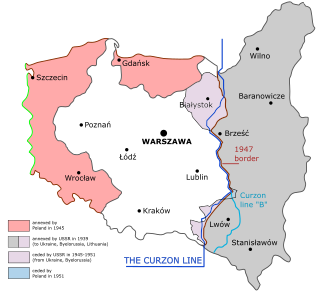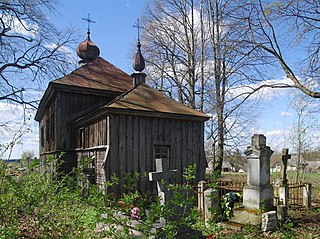
Volyn Oblast or simply Volyn is an oblast (province) in northwestern Ukraine. It borders Rivne Oblast to the east, Lviv Oblast to the south, Poland to the west and Belarus to the north. Its administrative centre is Lutsk. Kovel is the westernmost town and the last station in Ukraine on the rail line running from Kyiv to Warsaw. The population is 1,021,356.

The Curzon Line was a proposed demarcation line between the Second Polish Republic and the Soviet Union, two new states emerging after World War I. Based on a suggestion by Herbert James Paton, it was first proposed in 1919 by Lord Curzon, the British Foreign Secretary, to the Supreme War Council as a diplomatic basis for a future border agreement.

Seventeen days after the German invasion of Poland in 1939, which marked the beginning of the Second World War, the Soviet Union entered the eastern regions of Poland and annexed territories totalling 201,015 square kilometres (77,612 sq mi) with a population of 13,299,000. Inhabitants besides ethnic Poles included Belarusian and Ukrainian major population groups, and also Czechs, Lithuanians, Jews, and other minority groups.

The massacres of Poles in Volhynia and Eastern Galicia were carried out in German-occupied Poland by the Ukrainian Insurgent Army (UPA) with the support of parts of the local Ukrainian population against the Polish minority in Volhynia, Eastern Galicia, parts of Polesia and the Lublin region from 1943 to 1945. The ruling Germans also actively encouraged both Ukrainians and Poles to kill each other.

Eastern Borderlands or simply Borderlands was a term coined for the eastern part of the Second Polish Republic during the interwar period (1918–1939). Largely agricultural and extensively multi-ethnic with a Polish minority, it amounted to nearly half of the territory of interwar Poland. Historically situated in the eastern Polish–Lithuanian Commonwealth, following the 18th-century foreign partitions it was divided between the Empires of Russia and Austria-Hungary, and ceded to Poland in 1921 after the Treaty of Riga. As a result of the post-World War II border changes, all of the territory was ceded to the USSR, and none of it is in modern Poland.

The Ukrainian Insurgent Army was a Ukrainian nationalist paramilitary and partisan formation founded by the Organisation of Ukrainian Nationalists on October 14, 1942. During World War II, it was engaged in guerrilla warfare against the Soviet Union, and both the Polish Underground State and Communist Poland.

Operation Vistula was the codename for the 1947 forced resettlement of close to 150,000 Ukrainians from the south-eastern provinces of post-war Poland, to the Recovered Territories in the west of the country. The action was carried out by the Soviet-installed Polish communist authorities to remove material support to the Ukrainian Insurgent Army. The Ukrainian Insurgent Army continued its guerilla activities until 1947 in Subcarpathian and Lublin Voivodeships with no hope for any peaceful resolution; Operation Vistula brought an end to the hostilities.
The Belarusian minority in Poland is composed of 47,000 people according to the Polish census of 2011. This number decreased in the last decades from over 300,000 due to an active process of assimilation. Most of them live in the Podlaskie Voivodeship.

The Polish population transfers in 1944–1946 from the eastern half of prewar Poland, were the forced migrations of Poles toward the end and in the aftermath of World War II. These were the result of a Soviet Union policy that had been ratified by the main Allies of World War II. Similarly, the Soviet Union had enforced policies between 1939 and 1941 which targeted and expelled ethnic Poles residing in the Soviet zone of occupation following the Nazi-Soviet invasion of Poland. The second wave of expulsions resulted from the retaking of Poland from the Wehrmacht by the Red Army. The USSR took over territory for its western republics.
Repatriation of Polish population in the years of 1955–1959 was the second wave of forced repatriation of the Poles living in the territories annexed by the Soviet Union. The widely used term repatriation, promoted by decades of Polish communist propaganda, is a manipulation, an euphemism for an act of illegal expatriation.

The 1951 Polish-Soviet territorial exchange, also known as the Polish-Soviet border adjustment treaty of 1951, was a border agreement signed in Moscow between the Republic of Poland and the Soviet Union. It involved approximately 480 km2 (185 sq mi) of land along their shared border. The treaty was signed on February 15, 1951, ratified by Poland on May 28, 1951, and by the Soviet Union on May 31. It modified the border treaty of August 16, 1945, and came into effect on June 5, 1951. Since Poland was a satellite state within the Soviet sphere of influence, the exchange favored the Soviet Union economically due to the valuable coal deposits relinquished by Poland. Following the agreement, the Soviets constructed four large coal mines within eight years, with a combined annual mining capacity of 15 million tons.

Żmijowiska is a village in the administrative district of Gmina Wielkie Oczy, within Lubaczów County, Subcarpathian Voivodeship, in south-eastern Poland, close to the border with Ukraine. It lies approximately 2 kilometres (1 mi) south-east of Wielkie Oczy, 18 km (11 mi) south of Lubaczów, and 85 km (53 mi) east of the regional capital Rzeszów.

On the basis of a secret clause of the Molotov–Ribbentrop Pact, the Soviet Union invaded Poland on September 17, 1939, capturing the eastern provinces of the Second Polish Republic. Lwów, the capital of the Lwów Voivodeship and the principal city and cultural center of the region of Galicia, was captured and occupied by September 22, 1939 along with other provincial capitals including Tarnopol, Brześć, Stanisławów, Łuck, and Wilno to the north. The eastern provinces of interwar Poland were inhabited by an ethnically mixed population, with ethnic Poles as well as Polish Jews dominant in the cities, and ethnic Ukrainians dominating the countryside and overall. These lands now form the backbone of modern Western Ukraine and West Belarus.

The Border Agreement between Poland and the USSR of 16 August 1945 established the borders between the Union of Soviet Socialist Republics (USSR) and the Republic of Poland. It was signed by the Provisional Government of National Unity formed by the Polish communists. According to the treaty, Poland officially accepted the ceding its pre-war Eastern territory to the USSR (Kresy) which was decided earlier in Yalta already. Some of the territory along the Curzon line, established by Stalin during the course of the war, was returned to Poland. The treaty also recognised the division of the former German East Prussia and ultimately approved the finalised delimitation line between the Soviet Union and Poland: from the Baltic sea, to the border tripoint with Czechoslovakia in the Carpathians. The agreement entered into force on 5 February 1946.
The attack on Hrubieszów was a joint action of the Polish post-Home Army (AK) organization Freedom and Independence (WiN) and the Ukrainian partisans of the Ukrainian Insurgent Army (UPA), which took place on the night of 27 May 1946. It was the most significant joint action carried out by both organizations, which had previously often fought each other, but they decided to co-operate in the face of the common threat from the Polish communists and the Soviet NKVD.

Zakerzonia is an informal name for the territories of Poland to the west of the Curzon Line which used to have sizeable Ukrainian populations, including significant Lemko, Boyko populations, before the invasion of Poland by the Soviet Union and Nazi Germany in 1939, and were claimed as ethnically Ukrainian territories by Ukrainian nationalists in the aftermath of World War II. However, before 1939, the areas of Zakerzonia were mostly inhabited by Poles, who constituted about 70% of the population of this area. Ukrainians lived in a minority in Zakerzonia, constituting about 20% of the area's population.
The population exchange between Poland and Soviet Belarus at the end of World War II (1944–1947) was based on an agreement signed on 9 September 1944 by the Byelorussian SSR with the newly-formed Polish Committee of National Liberation (PKWN). It stipulated the resettlement of ethnic Belarusians from Poland to Belarus and of ethnic Poles and Jews who had Polish citizenship before September 17, 1939 from Belarus to Poland, in accordance with the resolutions of the Yalta and Tehran conferences and the plans about the new Belarus–Poland border. Similar agreements were signed with the Ukrainian SSR and the Lithuanian SSR ; the three documents are commonly known as the Republican Agreements.
The population exchange between Poland and Soviet Lithuania at the end of World War II (1944-1947) was based on an agreement signed on 9 September 1944 by the Lithuanian SSR with the newly-formed Polish Committee of National Liberation (PKWN). It stipulated the resettlement of ethnic Lithuanians from Poland to Lithuania and of ethnic Poles and Jews who had Polish citizenship before 17 September 1939 from Lithuania to Poland, in accordance with the resolutions of the Yalta and Tehran conferences and the plans about the new Lithuania–Poland border. Similar agreements were signed with the Ukrainian SSR and the Byelorussian SSR ; the three documents are commonly known as the Republican Agreements.

Beresteishchyna is a Ukrainian cultural and ethnic region in Western Polesie, in what is primarily the modern Brest Region of Belarus. Located along the western Bug, Beresteishchyna is one of three ethnically-Ukrainian territories in Belarus, alongside Pinshchyna and Starodubshchyna.
Polish-Ukrainian ethnic conflict - a series of armed clashes between Ukrainian guerrillas and Polish underground armed units between 1942 and 1945, whose direct continuation was the struggle of the Polish People's Army against the Ukrainian underground until 1947, with periodic participation of Soviet guerrilla units and the regular Red Army, as well as Romanian, Hungarian and German armed formations. The fighting initially took place in the south-eastern areas of the Second Polish Republic occupied by the Third Reich, and later in the Rzeszów and south-eastern parts of the Lublin Voivodeship of the so-called "People's Poland" and in the western areas of the Ukrainian Soviet Socialist Republic. There was also sporadic activity in the Romanian-occupied territories.













